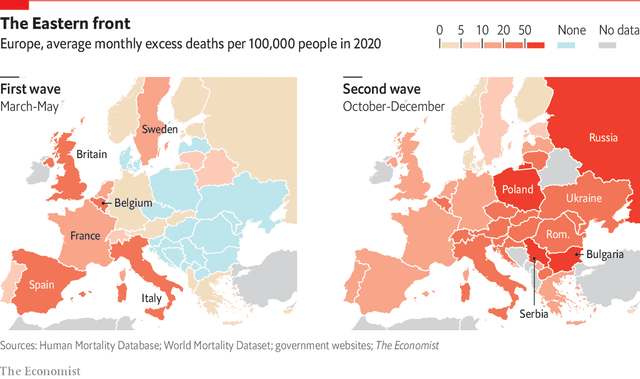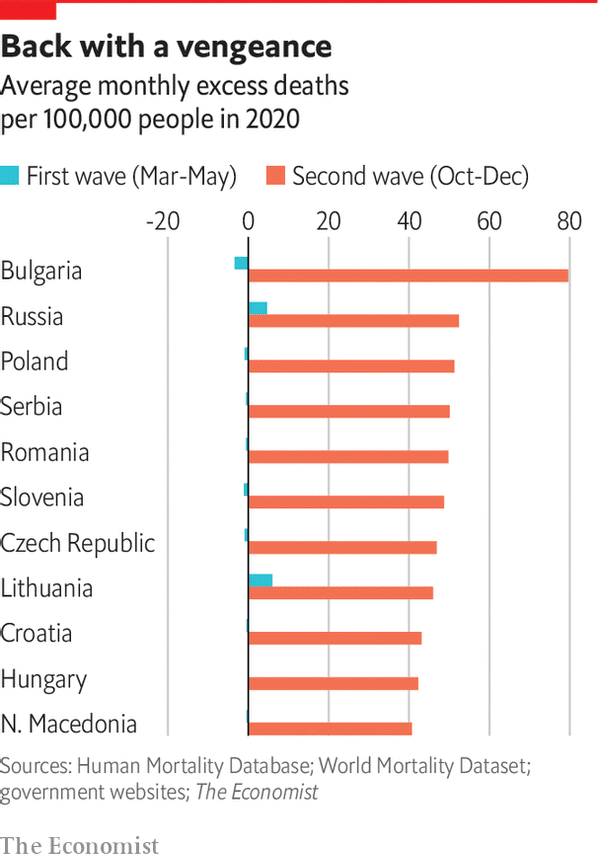They now have some of the world’s worst excess-mortality rates
ONE OF THE grimmest lessons from Spanish flu, which killed perhaps 50m people from 1918 to 1920, is that the second wave of a pandemic can be deadlier than the first. The latest evidence from Europe suggests that, in that continent at least, covid-19 has followed a similar pattern. An analysis by The Economist of mortality data from 46 countries, including Israel and some in Central Asia, suggests that between March and May 2020 there were about 220,000 “excess deaths” from all causes in the region—defined as the difference between observed and expected fatalities for that time of year. (These additional fatalities will probably be victims of covid-19, but may also include unexpected mortality from other causes.) Between October and December, the equivalent three-month total of excess deaths was at least 620,000. Most of the second-wave deaths occurred in eastern Europe..
In the spring, as the virus ravaged western Europe, countries in the former eastern bloc quickly introduced border controls and lockdowns, and were largely spared. Belgium, Britain, France, Italy, the Netherlands, Spain and Sweden accounted for almost all of the continent’s deaths. Each suffered a monthly excess-mortality rate of at least 12 people per 100,000 (averaged from March to May). The country in eastern Europe that got closest was Belarus, which recorded a monthly rate of 8 per 100,000, after imposing almost no restrictions on daily life. Others were markedly lower.
But as countries across the continent began to open their borders in the summer, the virus was able to make its way eastward. By the autumn, when infections began to rise again in Europe, they did so from Sicily to Siberia. At first it was difficult to work out exactly how bad the second wave was, owing to cross-country differences in testing and the quality of official statistics. Some doctors in Russia, for example, said the government’s death toll was implausibly low. Eastern governments that did release hospitalisation data showed a desperate picture. Bulgaria, Lithuania, Hungary, the Czech Republic and Croatia all had hospitalisation rates of at least 70 per 100,000 people at various points during November and December. No western European country has reached that threshold yet.
The latest mortality numbers for the continent are even more sobering. Our analysis of data from the Human Mortality Database, a collaboration between UC Berkeley and the Max Planck Institute in Germany, and the World Mortality Dataset, created by Ariel Karlinsky and Dmitry Kobak, shows that 11 eastern European countries recorded a monthly rate of at least 40 excess deaths per 100,000 people in October-December (see chart). That is more than any western European country suffered in the first wave. The region now occupies most of the top places on the excess-mortality table that The Economist has maintained since March.
The warning to the rest of the world is clear. Even countries that have endured the first year of covid-19 with few fatalities—either by geographical luck or governmental judgement—should be vigilant. With pandemics, there is never a guarantee that the latest wave will be the last.
Correction (February 16th): We have removed Armenia from a chart that ranks countries by excess mortality in October-December 2020. Most of Armenia’s excess deaths in that period were caused by the war against Azerbaijan in Nagorno-Karabakh.
By The Economist






